Papers by Purwantiningsih Sugita
Bioresource technology reports, Jul 1, 2024
Rasayan journal of Chemistry, Dec 31, 2022
Chemical Papers, Jan 13, 2024
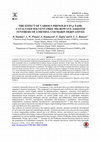
Rasayan journal of Chemistry, 2020
Coumarin derivatives from natural and synthetic sources are an important class of heterocyclic co... more Coumarin derivatives from natural and synthetic sources are an important class of heterocyclic compounds that displayed a broad spectrum of pharmacological properties. Among all coumarin derivatives, 4-methyl coumarin has been essentially used as a building block to afford various chemical structures. In this study, the effect of various phenolics and catalytic activity of p-TsOH for synthesizing 4-methyl coumarin derivatives has been investigated under conventional heating and microwave conditions. The highest yield of 4-methyl coumarin derivatives synthesis was achieved using resorcinol (60.10 + 2.9% yield) in the optimum reaction condition of starting materials molar ratio (1:1, resorcinol/ethyl acetoacetate, mol/mol) and 10 mol% of p-TsOH using 800W microwave irradiation at 80 o C for 180s under solvent-free condition. Microwave-assisted condition revealed a useful and simple method to synthesize coumarin derivatives through Pechmann condensation under neat and mild conditions with moderate to high yield, short reaction time, and easier product work-up using organic Brønsted acid catalyst.
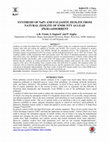
Rasayan journal of Chemistry, 2019
Synthesis of zeolite from Ende-Nusa Tenggara Timur (NTT) natural zeolite was conducted using the ... more Synthesis of zeolite from Ende-Nusa Tenggara Timur (NTT) natural zeolite was conducted using the hydrothermal method, both with and without the addition of Na2SiO3 and NaAlO2. This research was conducted to produce synthetic zeolite utilized to remove lead (Pb(II)) through the adsorption process. The temperature of crystal formation (aging) was performed at 60°C for 6 hours, and the hydrothermal process was at 100°C for 24 hours. The resulting synthetic zeolite included the NaP1 and faujasite types. The effects of adsorption parameters, such as pH and contact time, were identified. The best adsorption capacity was demonstrated by synthetic zeolite without the addition of Na2SiO3 and NaAlO2, with a value of144.7191 mg/g at pH 4, with a45 minute contact time. The results showed that the synthesis of zeolite performed by the hydrothermal method could increase the cation exchange capacity (CEC) up to 105.42cmol/kg, from a natural zeolite with aCECof20.14 cmol/kg. The Langmuir model was consistent with an isothermal adsorption equilibrium process, and the adsorption free energy (∆Gads) was consistent with physical adsorption (physisorption). The Nap1 zeolite of Ende-NTT natural zeolite was a better Pb(II) heavy metal adsorbent than the synthetic zeolites of fly ash and coal bottom ash.
South African Journal of Chemical Engineering, Jul 1, 2023
Nucleation and Atmospheric Aerosols, 2020
This study was conducted to investigate the physicochemical and antioxidant properties of Maillar... more This study was conducted to investigate the physicochemical and antioxidant properties of Maillard reaction products (MRP) prepared by heating whey protein isolate (WPI) and reducing sugars (glucose and galactose) to 95°C for different lengths of time (0-6 h). The results revealed that the colour, intermediate products, browning intensity and the antioxidant activities of the MRP increased as the reaction time increased (P < 0.05), whereas the pH value and free amino group content decreased (P < 0.05). Sodium dodecyl sulphate-polyacrylamide gel electrophoresis indicated that the covalently linked conjugates of WPI and sugars were formed. The results indicate that the Maillard reaction could improve the antioxidant capacity of WPI.
International Journal of Agriculture and Biosciences, 2017
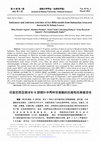
Journal of Hunan University Natural Sciences, Mar 28, 2022
Araucaria genera consist of 19 species, and three of them are grown in Botanical Garden, Bogor, I... more Araucaria genera consist of 19 species, and three of them are grown in Botanical Garden, Bogor, Indonesia. These plants were reported to contain biflavonoids and are primarily found in leaves. Biflavonoids display an extensive range of biological properties such as anti-inflammatory, anti-oxidant, anti-tumor, antivirus, anti-microbial, anti-fungal, etc. However, no studies reported secondary metabolites, especially biflavonoids, from Indonesian A. hunsteinii leaves. Therefore, this research aims to isolate biflavonoid from A. Hunsteinii leaves and evaluate their anticancer and antivirus activities. First, A. hunsteinii leaves were macerated in acetone to give brownish-black crude extract (14.66%, w/w). Then, the natural extract was fractionated and purified using chromatographic techniques with silica gel and Sephadex LH-20 as a stationary phase to afford two isolated compounds. The acetone extract and two isolated compounds were examined for their cytotoxic activity against breast cancer MCF-7 cells and human immunodeficiency virus (HIV) SRV-2 viruses based on an assay of 3-(4,5-Dimethylthiazol-2-yl)-2,5-diphenyltetrazolium bromide (MTT). According to spectroscopic data, including IR, UV-Vis, LC-MS/MS, and NMR (1 H, 13 C, NOESY, HSQC, and HMBC), two compounds were successfully elucidated as 4',7,7''-triO -methylcupressuflavone (1) and 4''',7,7''-triO -methylagathisflavone (2). Both compounds were first isolated from A. hunsteinii leaves. The preliminary MTT assay of compounds 1 and 2 against MCF-7 cells showed IC50 of 91.74 and 314.44 µg/mL, respectively. They had a larger IC50 than an acetone extract of A. hunsteinii leaves (IC50 of 62.16 g/mL), indicating that all samples had lower activity than the positive control, epirubicin HCl (IC50 of 0.52 g/mL). Furthermore, both compounds were ineffective as antivirus agents against SRV-2 viruses.
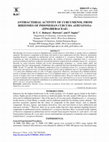
Rasayan journal of Chemistry, 2018
The rhizomes of Curcuma aeruginosa (Zingiberaceae), locally known as Temu Hitam, is usually used ... more The rhizomes of Curcuma aeruginosa (Zingiberaceae), locally known as Temu Hitam, is usually used as a traditional medicine. The bioactive compounds in this plant were known to have antibacterial activities. However, information regarding bioactive compounds on antibacterial activity contained in C. aeruginosa rhizomes is still limited. In continuing our study on Indonesian medicinal plants, the isolation of bioactive compounds from C. aeruginosa growing in Indonesia had been conducted. Curcumenol had been isolated from the methanol extract of C. aeruginosa rhizomes by using extraction methods and several chromatography techniques, i.e. vacuum liquid, radial, and preparative thin layer chromatography. Furthermore, this compound had been elucidated based on one-dimensional NMR (1 H and 13 C) and MS. The preliminary antibacterial assay of methanol extract of C. aeruginosa rhizomes on Salmonella typhi and Escherichia coli showed moderate activity with an inhibition zone of 7 mm (inhibition index of 1.17) and 6 mm (inhibition index of 1.00), in 50 ppm, respectively. Moreover, curcumenol also exhibited moderate activity in 50 ppm with 8 mm of inhibition zone (1.33 of inhibition index) on S. typhi while on E. coli showed weak activity in 50 ppm with 4 mm of inhibition zone (0.67 of inhibition index). However, both the methanol extract of C. aeruginosa rhizomes and curcumenol were inactive on Bacillus cereus and Staphylococcus aureus. It can be suggested that curcumenol played an important contribution to an antibacterial activity toward Gram-negative bacteria (S. typhi and E. coli) in C. aeruginosa rhizomes.
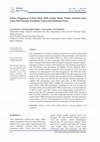
Jurnal riset kimia, Mar 24, 2023
The manufacture of vibration damping material from natural rubber (NR) required an increase in dy... more The manufacture of vibration damping material from natural rubber (NR) required an increase in dynamic properties, thermal stability, and resistance to heat. Using the Carbon Black N990 as a filler in NR vulcanizates can potentially increase on these properties. This research aims to study the effect of using Carbon Black N990 on dynamic properties, thermal stability, and aging resistance to heat in NR vulcanizates. The dynamic properties of NR vulcanizates were determined by Rubber Process Analyzer (RPA), while the thermal stability properties were studied by TGA, and heat resistance was determined by the thermal aging test. The RPA test results showed that adding 50 phr Carbon Black N990 in the NR compound could increase the value of the complex shear modulus to 65%. Furthermore, the results of the TGA test showed that the thermal stability properties of unfilled NR vulcanizates were better than that of NR vulcanizates containing Carbon Black N990. Unfilled NR vulcanizates were heat stable up to 353 o C, while NR vulcanizates containing 15, 30, and 50 parts per hundred rubber (phr) Carbon Black N990, respectively, were heat stable up to 348.1 o C, 348 o C, and 349 o C. Based on the requirements of ISO 4632-1, it showed that the NR compound containing Carbon Black N990 has good heat resistance properties. The NR compound formula contains 30 phr Carbon Black N990 showing good dynamic properties and heat resistance in accordance with EN 15129 requirements so that it has the potential to be used as a vibration damping material for earthquake-resistant structures.
Rasayan journal of Chemistry, 2022
The rhizomes of Curcuma amada (Zingiberaceae), locally recognized as Temu Mangga (Mango Ginger), ... more The rhizomes of Curcuma amada (Zingiberaceae), locally recognized as Temu Mangga (Mango Ginger), are usually consumed as herbal medicine since they show antibacterial anticancer antihyperglycemic, and antitubercular activities. Many reports were also explored for its terpenoid contents, but the information of phenolic compounds from C. amada is still limited. This research aims to isolate phenolic compounds from the ethanol extract of C. amada rhizomes grown in Bogor, Indonesia. C. amada rhizomes were macerated in ethanol to give brownish-black crude extract (5.084%, w/w). The crude extract then was fractionated and purified using a sequence of chromatographic techniques to afford two isolated fractions, C1 and F1. According to UV-Vis, FTIR, and LC-MS spectral data, the C1 and F1 fractions were identified as curcumin and naringenin, respectively.
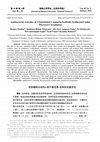
Journal of Hunan University Natural Sciences, Jan 28, 2022
Global infections, such as diarrhea and acute respiratory disease, have urged the researchers in ... more Global infections, such as diarrhea and acute respiratory disease, have urged the researchers in this area to discover coumarin-scaffold antibacterial agents, most widely used therapeutic drugs worldwide. This research aims to synthesize 3-substituted coumarins using microwave-assisted and evaluate their antibacterial activities against Escherichia coli and Staphylococcus aureus. In this study, salicylaldehyde with numerous activated methylenes has been used to synthesize 3-substituted coumarins following Knoevenagel condensation assisted by microwave irradiation. The highest yield of 3-acetylcoumarin was achieved using ethyl acetoacetate at the molar ratio of 1.2:1 (mol/mol) and 30 mol% of diethylamine using 100W microwave irradiation for 60 s under neat condition (43.65+0.50%). Moreover, ethyl coumarin-3-carboxylate (16.33%) was successfully synthesized using the optimum condition of 3-acetylcoumarin from diethyl malonate as activated methylene with a longer reaction time (900 s). However, the trial to afford 3-cyanocoumarin was failed from ethyl cyanoacetate and malononitrile as activated methylenes under the optimum condition of 3-acetylcoumarin. The inhibition zones of 3acetylcoumarin and ethyl coumarin-3-carboxylate on disc diffusion assay towards E. coli at concentrations higher than 250 ppm showed weak activity, ranging from 1.9-3.6 mm. In contrast, both compounds showed no inhibition zone against S. aureus at all tested concentrations. This finding reveals that 3-substituted coumarins can be synthesized by low wattage microwave irradiation and solvent-free with moderate yield with ethyl acetoacetate is the most reactive methylene. Furthermore, this work proposes some corrections to assign proton and carbon chemical shifts in 3-substituted coumarins by analyzing HSQC and HMBC experiments in NMR measurement.
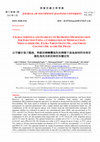
Xinan Jiaotong Daxue Xuebao, Feb 28, 2022
Injectable ibuprofen has been formulated as nanoemulsion, prodrug microemulsion, and freeze-dried... more Injectable ibuprofen has been formulated as nanoemulsion, prodrug microemulsion, and freeze-dried. However, its application is limited because of solubility, high dosing, and complex formulation. Microemulsion ibuprofen injection is an alternative dosage form that increases solubility and bioavailability. The study aimed to formulate an ibuprofen microemulsion injection that can fulfill the prerequisites for injection preparations with a simple method and simple reconstitution before use. All combinations of the oil and aqueous phases were formed using the self-emulsification technique. The optimum stability was estimated on particle size, polydispersity index (PDI), and zeta potential at 5C, 25C, and 40C for 120 days. Based on the minimum amount of Tween 80, drug loading, and the highest transmittance value, the optimal microemulsion formula was obtained at a concentration of 2.8% (1:1 combination of olive oil and medium-chain triglyceride oil), 11.2% Tween 80, 2.8% propylene glycol, and 83.2% water for injection. The optimal formula has a droplet size of 16.7 ± 11.2 nm, a zeta potential of 0.8 mV, and a PDI of 0.196. The formula was stable at 45C storage for up to 14 days, at 25C, and at 5C, steady at 120 days based on droplet size diameter of 21.27 ± 0.00 nm, zeta potential-1.3 0.10 mV, and PDI 0.38 0.02. The optimum formula by simple reconstitution without additional isotonization has fulfilled the requirements for injection preparation. It was concluded that the ibuprofen microemulsion with a combination of medium-chain triglyceride oil and olive oil could form a stable microemulsion and

Journal of chemical and pharmaceutical research, Dec 1, 2018
Curcuma heyneana (Zingiberaceae) is one of the zingiberaceous plants indigenous to Java Island, I... more Curcuma heyneana (Zingiberaceae) is one of the zingiberaceous plants indigenous to Java Island, Indonesia which commonly known as Temu Giring. The rhizome of this plant is considered to be useful for treatments of skin diseases, abrasions, and injuries due to the antibacterial compounds contained in this plant. However, there is still scarce information regarding antibacterial compounds contained in C. heyneana rhizomes. In searching of antibacterial compound, isolation of secondary metabolites from Indonesian C. heyneana had been conducted. Curcumenol had been successfully isolated from methanol extract of C. heyneana rhizomes using extraction and various chromatography techniques. This compound had been elucidated using FTIR, GCMS, and NMR (1D and 2D). Curcumenol showed weak antibacterial activity in 50 ppm with inhibition zone of 4 mm and inhibition index of 0.67 towards Escherichia coli (Gram negative) while this compound was inactive towards Staphylococcus aureus (Gram positive).
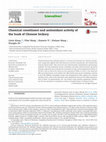
Drug Invention Today, 2018
Chinese hickory (Carya cathayensis Sarg.) is a common and nutritious nut. Twenty-nine phenolic co... more Chinese hickory (Carya cathayensis Sarg.) is a common and nutritious nut. Twenty-nine phenolic compounds, together with three quinones and three triterpenoids, were isolated from Chinese hickory husks. Their structures were determined by comprehensive spectroscopic methods. The total methanolic extract, chloroform and ethyl acetate fractions and all the isolated compounds were evaluated for antioxidant activity and neuroprotective effects on SH-SY5Y cells, as well as the effects on the expression of PPAR-γ in 3T3-L1 cells. Quercetin (10) and protocatechuic acid methyl ester (24) showed pronounced antioxidant activities in all of the different antioxidant assays and neuroprotective effect against H2O2-induced oxidative stress. Some of the flavonoids could significantly decrease the mRNA expression level of PPAR-γ by approximately 70%. The present study provided supplement information for the evaluation of antioxidant activity and health benefit of Chinese hickory.











Uploads
Papers by Purwantiningsih Sugita